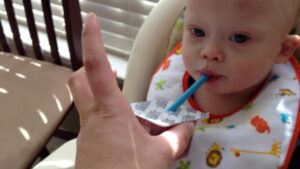
Introduction
Teaching a baby to use a straw is a small yet significant milestone in their development. It not only encourages independent drinking but also supports oral motor skills, which are essential for speech development. But where do you start? In this guide, we’ll break down every step of teaching your baby to use a straw, ensuring it’s both a fun and rewarding experience for you and your little one.
Why Learning to Use a Straw is Important for Babies
Learning to use a straw offers numerous benefits:
- Promotes Independence: Babies start drinking without relying on bottles or sippy cups.
- Improves Oral Motor Skills: Strengthens muscles used for swallowing, chewing and even speech.
- Reduces Dental Risks: Unlike bottles, straws encourage healthier drinking habits that may reduce prolonged exposure to sugary liquids.
- Supports Transition to Regular Cups: Makes it easier to transition to open cups over time.
Straw drinking is a valuable skill that many parents aim to introduce around 6 to 9 months, but it’s never too late to start!
When Should You Start Teaching a Baby to Use a Straw?
Most babies are ready to start learning how to use a straw around 6 to 9 months. At this stage:
- They are beginning to explore solid foods.
- They develop better control over their tongue and mouth.
- They show interest in how others drink.
However, readiness varies for each baby. Watch for cues like curiosity about your cup or successful sipping from a sippy cup as signs they’re ready.
Choosing the Right Straw and Cup for Training
Before you begin, you’ll need the right tools. Not all straws are baby-friendly, so selecting the appropriate one is key. Here’s what to consider:
Types of Straw Training Cups
- Soft Silicone Straws: Gentle on sensitive gums.
- Weighted Straws: Allow the liquid to flow no matter how the cup is tilted.
- Built-In Spill-Proof Cups: Ideal for minimizing mess during practice.
Recommended Products for Beginners
- Munchkin Weighted Straw Trainer Cup
- Honey Bear Straw Cup (used for therapeutic training)
- Nuby Flex Straw Cup
Why These Work
These designs cater to baby-friendly ergonomics, offering soft, flexible straws that make sucking easier for little learners.
Step-by-Step Guide: How to Teach a Baby to Use a Straw
Teaching your baby to use a straw can be a breeze if approached systematically. Here’s a breakdown:
Step 1: Get Your Baby Familiar with a Straw
Start by introducing the straw. Let them hold it and chew on it to become accustomed to its texture and shape.
Step 2: Use a Straw Trainer or Pre-Filled Straw
Fill the straw with liquid and gently place your finger over the top to keep it sealed. Allow the liquid to drip into your baby’s mouth. This helps them associate the straw with drinking.
Step 3: Encourage Suction
Once they understand liquid comes from the straw, encourage them to suck. You can demonstrate the action by drinking from a straw yourself. Babies often mimic what they see.
Step 4: Transition to a Training Cup
Introduce a training cup with a built-in straw. These cups regulate the flow of liquid, making it easier for your baby to practice sucking without overwhelming them.
Step 5: Practice with Water or Milk
Start with water or breastmilk/formula, as these are familiar flavors. Avoid introducing juices initially to ensure your baby doesn’t develop a preference for sugary drinks.
Common Challenges and How to Overcome Them
Teaching a baby to use a straw isn’t always straightforward. Here are some common issues parents face and solutions:
1: Baby Doesn’t Understand Sucking
- Solution: Use a honey bear straw cup or pre-filled straw to guide the liquid to their mouth, encouraging them to try sucking.
2: Baby Chews the Straw
- Solution: Redirect their focus by showing them how you sip from a straw and encouraging imitation.
3: Refusal to Try
- Solution: Make the experience playful by adding a favorite drink or using fun, colorful straws to spark interest.
Tips to Make Straw Training Easier
- Be Patient: Babies learn at their own pace, so don’t rush the process.
- Make it Fun: Use silly sounds, cheers, or songs to keep your baby engaged.
- Offer Praise: Celebrate small victories to motivate continued effort.
- Practice Regularly: Incorporate straw drinking during mealtime or snack time.
Signs Your Baby is Ready for Independent Straw Use
Watch for these milestones to gauge your baby’s progress:
- Successfully sucking liquid through the straw without assistance.
- Reduced spilling or dribbling during drinking.
- Ability to transition from assisted to independent straw use.
Once these are achieved, your baby is well on their way to mastering this skill!
FAQs: Common Concerns About Straw Training
Q1: Can my baby skip sippy cups and go straight to straws?
Yes! Straw cups are often a better choice than sippy cups as they promote healthier oral development.
Q2: What if my baby doesn’t like the straw?
Experiment with different straw types or introduce a favorite drink to spark interest.
Q3: Are there safety concerns with straw cups?
Ensure the straw and cup are BPA-free and designed for babies. Always supervise drinking to avoid choking hazards.
Q4: How long does it take for a baby to learn to use a straw?
It varies. Some babies pick it up within days, while others may take a few weeks of consistent practice.
Q5: Can I use juice for straw training?
It’s better to start with water or milk to avoid forming a preference for sugary drinks.
Conclusion
Teaching your baby to use a straw is an exciting step that fosters independence and supports developmental milestones. By choosing the right tools, practicing patience, and using playful techniques, you’ll make the journey enjoyable for both you and your baby. Remember, every baby learns at their own pace, so celebrate each small success along the way.

